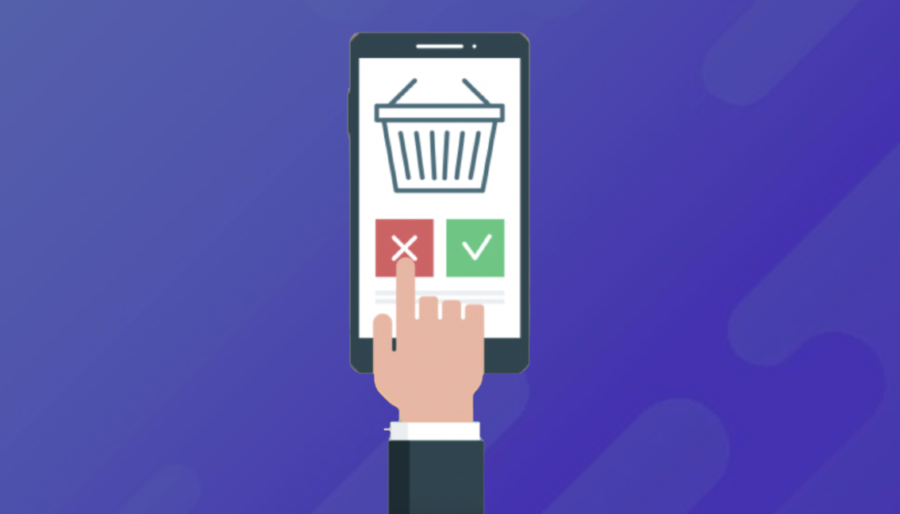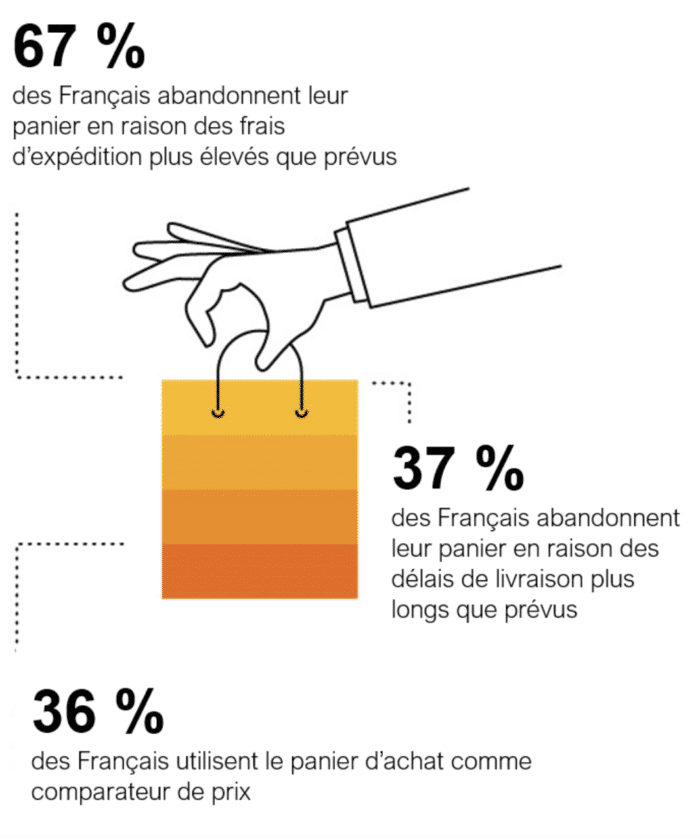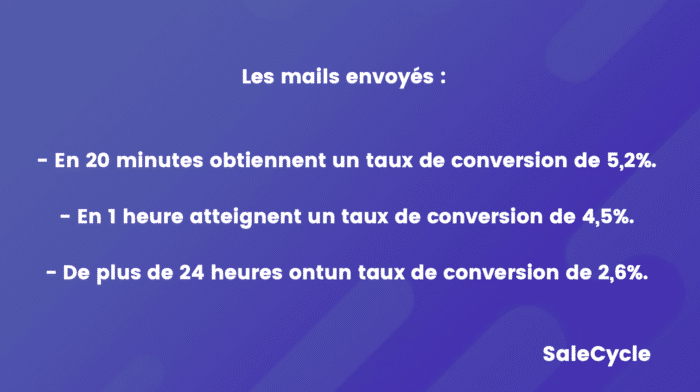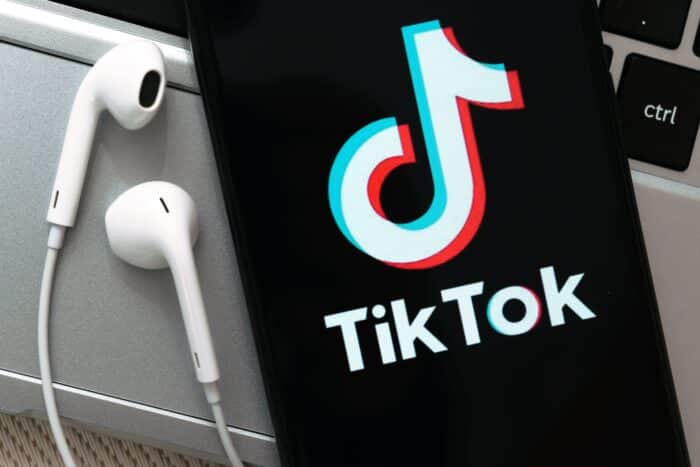
We’ve all been there. You see a few items you like on an online store and add them to your basket, but you never get round to completing your purchase.
Don’t worry, it’s completely normal! In France, 75.8% of online baskets do not result in a sale. In other words, three quarters of people abandon the items they wanted to buy.
The purpose of this article is to understand the main reasons for this behaviour, and to give you some tips for increasing your conversion rate by successfully following up with customers.
Abandoned basket – definition and causes
Before any of that, let’s get back to what exactly is an abandoned basket.
The abandoned basket is just like a shopping basket or supermarket trolley that you fill up and then leave in front of the tills, without ever completing your purchase.
The list of items you intend to buy from an online store is symbolised by a virtual basket, which is what customers abandon at the last moment when they leave the page before buying.
It’s absolutely essential to know why consumers behave like this in order to limit it. This is what will enable you to improve the customer’s buying experience. Indeed, ignoring abandoned baskets, especially when the rate is high, can lead to a significant shortfall in your turnover.
There are obviously many different reasons, and this is what we will analyse below.
The main causes of abandoned baskets
If a customer’s interactions with your online store didn’t lead to a sale, it could potentially be for one of many reasons.
While it’s impossible to know exactly why some customers abandon their purchases, the most obvious obstacle is trust.
Firstly, the reason that comes up most often is the client’s lack of confidence in a company that they know little or nothing about. You can avoid this by ensuring potential customers see how trustworthy your company is thanks to brand awareness, which is why reviews and customer feedback are essential.
There are many reasons that people abandon their online baskets, but the most common are:
- Price
We’ve all been there. You add a whole host of items that you want to buy to your shopping basket, only to end up abandoning the purchase because of the price is too high.
In the competitive world of price comparison sites, you must absolutely make sure you stand out as being among the cheapest (if not the cheapest), at least on a choice of items that will be your loss-leaders. Customers who know you’re the cheapest for some products will always come back for your great value on other products.
- Hidden additional costs
When you’re happy with the items you’ve put in your basket and you get to the checkout page, it’s frustrating to see that some e-commerce sites add unexpected costs such as taxes or fees.
Added to this are companies that offer free delivery for sales over a certain price. Nobody likes this, though. Sometimes these policies can seem to push the price up to above what you’re comfortable paying, or sometimes they just seem downright cheeky.
Also, nothing is more infuriating for customers than a site that doesn’t clearly state how much they will ultimately have to pay.
Generally in this case, when you get through to checkout and the delivery charge is added, sometimes the final amount ends up being prohibitive. These additional fees will scare away your customers or limit their purchases on your site. It’s therefore essential to choose a reliable and cost-effective delivery partner.
- Limited means of payment
When the checkout process requires multiple steps, the customer may lose patience and walk away from the sale. The fewer payment steps, the better. Again, make sure you have a good financial partner, there are a number of reliable online payment platforms today.
- The obligation to create an account
Customers are very often expected to create an account to complete their order. However, the time that takes and the prospect of having their data harvested can turn customers away.
Allow customers to come back to your website if they liked your products instead of bombarding them with reminders and/or unwanted emails.
- The lack of security on the e-commerce site
In Maslow’s hierarchy of needs, the need for security is essential to the purchasing process. A lack of clarity about your company, your contact details, etc. also have an impact on a customer’s sense of security.
You can instil confidence in your site visitors by showcasing the certifications your products have received and the security protocols in place for handling payment.
It’s very often simply for these reasons that customers decide to abandon their baskets and not go through with the sale.
So, how can you solve this problem?
How to follow up with customer who have abandoned their baskets
Here are some of our tips for following up with customers who have walked away from your site without completing their purchase.
- On social media
Retargeting is an advertising method for serving customers who have already visited your online store ads that encourage them back to place an order.
Since the customer had already put items in their basket, it’s safe to assume that they were interested in them. So, with subtle and respectful retargeting, they probably wouldn’t think twice about going back to your site to complete their purchase. Be careful, though, not to spam potential customers.
- Emailing
The most frequent and effective follow-up method remains emailing.
If the customer has provided their email address and has agreed to receive emails (GDPR) containing news from your company, promotional offers, etc., you can contact them this way.
Thanks to email reminders with tools like Klaviyo, you can remind customers that their baskets are still there for them.
Also, in order to encourage the customer back to complete the sale, you can sweat talk them with a promo code, some goodies, free or reduced delivery costs, etc. Be inventive and innovative so that the customer wants to come back to make the purchase!
So, when should I follow up with the customer? When is the timing right?
After the first follow-up, time is decisive.
Care must be taken not to follow up with the client too soon after abandoning their basket, nor too late. Too early and the customer could feel pressured to buy. Too late and they might have already made a purchase from a competitor.
The ideal time between a basket being abandoned and the follow-up email should not exceed 24 hours, if you want to obtain a significant conversion rate.
We hope that with this analysis, you can better adapt your approach to abandoned shopping baskets.
Either way, Neads is here to help you in your quest for customers and work out the most appropriate solutions with you.
Contact us!








